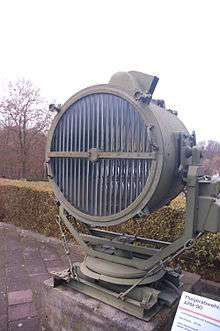Aerobeacon

An aerobeacon is a light assembly used to create a fixed or flashing signal visible over long distances. It consists of a high intensity electric lamp mounted with a focusing device in a cylindrical housing, which usually is rotated on a vertical axis with an electric motor. The sweep of the narrow beam thus produced gives the flashing effect. Aerobeacons were originally developed for aviation use, most familiarly as aerodrome beacons, but they also saw extensive use in lighthouses. They were far cheaper to manufacture and maintain than classic glass Fresnel lenses, and more rugged; and they could be mounted exposed to the weather. Historic models include the DCB-24, which used a single parabolic reflector; the DCB-224, a double-beamed version of the DCB-24; and the DCB-36, which used a system of plastic Fresnel lenses. Manufacturers included Carlisle & Finch and the Crouse-Hinds Company. They are still in widespread use.
See also
References
- Pepper, Terry. "The DCB Series Aerobeacon". Retrieved 2012-06-14.
- Trapani, Jr., Bob. "DCB-36 Beacon: Fading Away and All but Forgotten by History". Retrieved 2012-06-14.
- "DCB-24 and DCB-224 Rotating Searchlights (datasheet)". Richard Holmes. Retrieved 2012-06-14.
External links
- photos of a DCB-36 installation at the Massey Air Museum
_-_cropped.jpg)